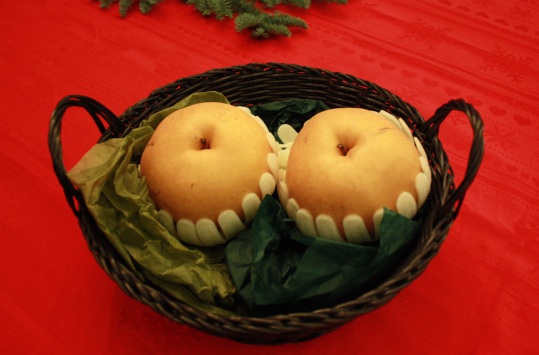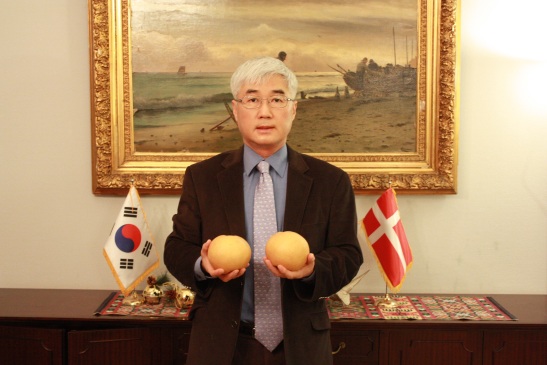Korea-grown Asian pears are gaining popularity in Denmark these days.
In celebration of the New Year, the Korean Embassy in Copenhagen sent a pair of pears in baskets to the royal court, to the prime minister's office, to parliament, to the Supreme Court and to the Danish diplomatic corps.
It has received unexpected positive responses. The gift recipients seem to enjoy the fruit, saying that, "It's as large as one's head," "It's full of sweet juice," and, "It feels good to munch on."


There were also remarks that Korean Ambassador Ma Young-sam's referring to it in his message as, "a pair of pears," sounded rhythmical and interesting.
Asian pears from the city of Naju in Jeollanam-do (South Jeolla Province) were first introduced in Denmark in early October during a food festival hosted by the Korean Embassy there. The local Danes who tasted the fruit at the festival praised the delicious fruit, giving the Korean Embassy the idea for a New Year's gift.
According to the local Korean Embassy and the Copenhagen office of the Korea Trade-Investment Promotion Agency (KOTRA), the promotion of Asian pear exports is now being considered, raising the possibility of the fruit being sold in markets in Demark later this year.
The city of Naju, in central-western Jeollanam-do, is ideal for the cultivation of Asian pears in terms of its climate, geography and topography. In particular, there are many hills in the region. There are other regions that grow pears, too, but the flavor of fruit from those regions can never be as good as the flavor found in Naju's pears. Korean Asian pears are cultivated in the autumn and are stored until the freezing winter. Winter is regarded as the best time of the year for the sweet, cool and crunchy fruit.
By Wi Tack-whan, Lee Seung-ah
Photos courtesy of the Ministry of Foreign Affairs
Korea.net Staff Writers
whan23@korea.kr
In celebration of the New Year, the Korean Embassy in Copenhagen sent a pair of pears in baskets to the royal court, to the prime minister's office, to parliament, to the Supreme Court and to the Danish diplomatic corps.
It has received unexpected positive responses. The gift recipients seem to enjoy the fruit, saying that, "It's as large as one's head," "It's full of sweet juice," and, "It feels good to munch on."


Naju pears that Ambassador Ma sent to some government bodies in Denmark have received unexpected positive responses.
There were also remarks that Korean Ambassador Ma Young-sam's referring to it in his message as, "a pair of pears," sounded rhythmical and interesting.
Asian pears from the city of Naju in Jeollanam-do (South Jeolla Province) were first introduced in Denmark in early October during a food festival hosted by the Korean Embassy there. The local Danes who tasted the fruit at the festival praised the delicious fruit, giving the Korean Embassy the idea for a New Year's gift.
According to the local Korean Embassy and the Copenhagen office of the Korea Trade-Investment Promotion Agency (KOTRA), the promotion of Asian pear exports is now being considered, raising the possibility of the fruit being sold in markets in Demark later this year.
The city of Naju, in central-western Jeollanam-do, is ideal for the cultivation of Asian pears in terms of its climate, geography and topography. In particular, there are many hills in the region. There are other regions that grow pears, too, but the flavor of fruit from those regions can never be as good as the flavor found in Naju's pears. Korean Asian pears are cultivated in the autumn and are stored until the freezing winter. Winter is regarded as the best time of the year for the sweet, cool and crunchy fruit.
By Wi Tack-whan, Lee Seung-ah
Photos courtesy of the Ministry of Foreign Affairs
Korea.net Staff Writers
whan23@korea.kr
Most popular
- Grammy-winning producer calls Suga of BTS 'amazing artist'
- 'Universal love, family' themes fuel success of 'King of Kings': director
- Council sets minimum hourly wage in 2026 at KRW 10,320
- Expansion of foreign app system raises tourist convenience
- Nat'l population diversity rose nearly 8% from 2018-22: study
